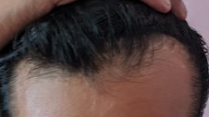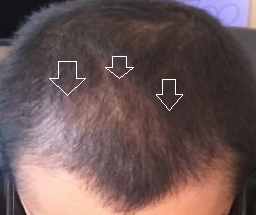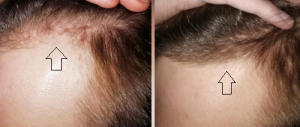It looks like you are receding asymmetrically more on the left than the right. This is common and the other side will eventually catch up. Finasteride is a good treatment for this. Look at this example: https://baldingblog.com/male-20-on-finasteride-90-days-photo/
This article suggest that this is the case: https://www.ncbi.nlm.nih.gov/pubmed/17910907
I’m 21. My father has a normal hairline, and my maternal grandfather has a head of hair too (it’s gotten thinner and seems to have definitely matured but he’s 80 for god’s sake). I thought I’d be in the clear since those two are likely the most important genetic indicators for whether I’ll go bald or not, but I’m worried that my hairline indicates balding anyway. Am I safe? The last two photos is my grandfather’s current hairline and my hairline one year ago, my hair being a bit shorter.
There is no way to tell what will happen to you. With good haired relatives, it reduces the statistical risk of balding for you, but does not eliminate it if there is any balding in the family line (either side of the family)
The problem, of course, even if this is true and it works, the questions is what is the safety and effectiveness of this mushroom? Will it produce sexual and other side effects. Clearly, we don’t know how to dose it?
https://pubmed.ncbi.nlm.nih.gov/16029938/
I’m wondering if its possible to begin to have a receding hairline/thinning crown/diffuse thinning, without there being an associated increase in hair shedding (i.e. when styling hair, washing it, on bed). Every article I read says that MPB puts more hair in the shedding phase, so that should mean MPB and shedding are correlated. But isnt it possible to go bald without any noticable increase in shedding? In other words, maybe the 50 – 100 hairs you lose a day, while normal by all metrics, simply just dont grow back.
I would think that for diffuse thinners/crown thinning, there has to be an increase in shedding since it covers so much area… But for hairline recession maybe less so because the temples are a smaller region?
Recession and balding can occur separately, but developing an extensive balding pattern will produce shedding in all men eventually
I started using min and ive noticed very tiny hairs growing on my forehead way below my hairline and temple are between my eyes and hairline. Is this an unusual sign or is this common? Also my temples are receding slightly and the top is fine.
Hair growth in unwanted areas is a known side effect of systemic absorption of the minoxidil. Women have real problems if they develop a beard or mustache on minoxidil; also a known side effect.
I’m nearly 25 and my hair is slowly getting worse I want to start finasteride but not sure if its wise to delay it Some of the reasons why I’m thinking of delaying. 1 potential side effects / permentant change in hormonal profile 2 possibility of hair getting worse 3 long term cost. At the same time I want to start to keep what I have
If you take finasteride and, worst case, get side effects of any sort, you can stop the medication. In my fairly extensive experience I have never seen permanent side effects that don’t go away with stopping it.
You have early balding with a Class 3A Norwood pattern with a persistent forelock. The forelock can be strong in some men and if it lasts till the age of 35, it usually lasts your lifetime even if you continue to bald in the ‘A’ pattern. You can see the thinning around the forelock from the photos and the arrows show the upper part of the 3A balding pattern.
Take a look at Catherine Zeta–Jones‘s hairline (images on google) and you will note that the distance between the hairline and the grove between the nose (Glabella) and the distance between the tip of the nose and the chin are equal. A balanced hairline therefore is critical to femininity. Add to that the shape of the hairline on this actress as it is round. Men have V-Shaped hairlines, not rounded as a rule so the shape of the hairline controls the femininity issue as you can see in this link: https://newhair.com/before-and-after/hairlinelowering/#results how hair transplants can control both of these factors.
This Reddit poster did a good job at summarizing the key elements everyone must understand. I would add:
1- understand that genetic balding is progressive and over the years more hair loss may occur until you reach your final genetic pattern so your Personalized Master Plan should account for this possibility
2- be sure you research the doctor you are going to use and develop a Personalized Master Plan for your hair loss with that doctor so you can set realistic expectations. Although coarse hair is the best hair caliber, many men get great results with medium weight hair and even fine hair if the balding pattern is not very extensive.
3- realize that over the years, hair character changes with age, often becoming finer so plan for these changes in your Personalized Master Plan
What Makes a Good Candidate for Hair Transplantation Surgery from tressless
My best friend has a literally perfect juvenile hairline, not a single out of place or thinned hair, complete thickness, length, literally perfect as if he was 10 years old.
My grandfather (mother’s father) had a perfect juvenile hairline and no hair loss when he died at 102. It happens and not everyone loses their hair or their juvenile hairline. Most of his sons had perfect hairlines as well and the children of these men might inherit the same hairline qualities.
Page 223 of 1247





